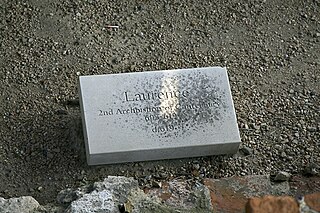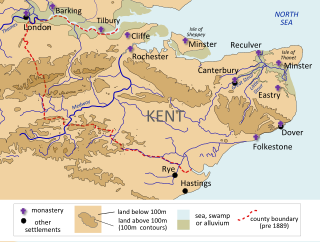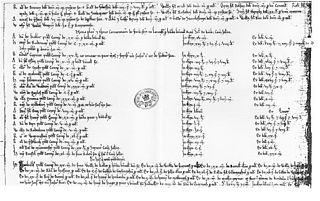
Augustine of Canterbury was a monk who became the first Archbishop of Canterbury in the year 597. He is considered the "Apostle to the English" and a founder of the English Church.

Laurence was the second Archbishop of Canterbury, serving from about 604 to 619. He was a member of the Gregorian mission sent from Italy to England to Christianise the Anglo-Saxons from their native Anglo-Saxon paganism, although the date of his arrival is disputed. He was consecrated archbishop by his predecessor, Augustine of Canterbury, during Augustine's lifetime, to ensure continuity in the office. While archbishop, he attempted unsuccessfully to resolve differences with the native British bishops by corresponding with them about points of dispute. Laurence faced a crisis following the death of King Æthelberht of Kent, when the king's successor abandoned Christianity; he eventually reconverted. Laurence was revered as a saint after his death in 619.
Saint Mellitus was the first bishop of London in the Saxon period, the third Archbishop of Canterbury, and a member of the Gregorian mission sent to England to convert the Anglo-Saxons from their native paganism to Christianity. He arrived in 601 AD with a group of clergy sent to augment the mission, and was consecrated as Bishop of London in 604. Mellitus was the recipient of a famous letter from Pope Gregory I known as the Epistola ad Mellitum, preserved in a later work by the medieval chronicler Bede, which suggested the conversion of the Anglo-Saxons be undertaken gradually, integrating pagan rituals and customs. In 610, Mellitus returned to Italy to attend a council of bishops, and returned to England bearing papal letters to some of the missionaries.

The Witan was the king's council in Anglo-Saxon England from before the seventh century until the 11th century. It was composed of the leading magnates, both ecclesiastic and secular, and meetings of the council were sometimes called the Witenagemot. Its primary function was to advise the king on subjects such as promulgation of laws, judicial judgments, approval of charters transferring land, settlement of disputes, election of archbishops and bishops and other matters of major national importance. The witan also had to elect and approve the appointment of a new king. Its membership was composed of the most important noblemen, including ealdormen, thegns, and senior clergy.

Offa was King of Mercia, a kingdom of Anglo-Saxon England, from 757 until his death. The son of Thingfrith and a descendant of Eowa, Offa came to the throne after a period of civil war following the assassination of Æthelbald. Offa defeated the other claimant, Beornred. In the early years of Offa's reign, it is likely that he consolidated his control of Midland peoples such as the Hwicce and the Magonsæte. Taking advantage of instability in the kingdom of Kent to establish himself as overlord, Offa also controlled Sussex by 771, though his authority did not remain unchallenged in either territory. In the 780s he extended Mercian Supremacy over most of southern England, allying with Beorhtric of Wessex, who married Offa's daughter Eadburh, and regained complete control of the southeast. He also became the overlord of East Anglia and had King Æthelberht II of East Anglia beheaded in 794, perhaps for rebelling against him.

The Kingdom of the Kentish, today referred to as the Kingdom of Kent, was an early medieval kingdom in what is now South East England. It existed from either the fifth or the sixth century AD until it was fully absorbed into the Kingdom of Wessex in the late 9th century and later into the Kingdom of England in the early 10th century.

Danegeld was a tax raised to pay tribute or protection money to the Viking raiders to save a land from being ravaged. It was called the geld or gafol in eleventh-century sources. It was characteristic of royal policy in both England and Francia during the ninth through eleventh centuries, collected both as tributary, to buy off the attackers, and as stipendiary, to pay the defensive forces. The term danegeld did not appear until the late eleventh century. In Anglo-Saxon England tribute payments to the Danes was known as gafol and the levy raised to support the standing army, for the defense of the realm, was known as heregeld (army-tax).

In the civil service of the United Kingdom, His Majesty’s Exchequer, or just the Exchequer, is the accounting process of central government and the government's current account in the Consolidated Fund. It can be found used in various financial documents including the latest departmental and agency annual accounts.
A fyrd was a type of early Anglo-Saxon army that was mobilised from freemen or paid men to defend their Shire's lords estate, or from selected representatives to join a royal expedition. Service in the fyrd was usually of short duration and participants were expected to provide their own arms and provisions. The composition of the fyrd evolved over the years, particularly as a reaction to raids and invasions by the Vikings. The system of defence and conscription was reorganised during the reign of Alfred the Great, who set up 33 fortified towns in his kingdom of Wessex. The amount of taxation required to maintain each town was laid down in a document known as the Burghal Hidage. Each lord had his individual holding of land assessed in hides. Based on his land holding, he had to contribute men and arms to maintain and defend the burhs. Non-compliance with this requirement could lead to severe penalties.
A hundred is an administrative division that is geographically part of a larger region. It was formerly used in England, Wales, some parts of the United States, Denmark, Southern Schleswig, Sweden, Finland, Norway, the Bishopric of Ösel–Wiek, Curonia, the Ukrainian state of the Cossack Hetmanate and in Cumberland County in the British Colony of New South Wales. It is still used in other places, including in Australia.
The Saladin tithe, or the Aid of 1188, was a tax, or more specifically a tallage, levied in England and to some extent in France in 1188, in response to the capture of Jerusalem by Saladin in 1187.

The Pipe rolls, sometimes called the Great rolls or the Great Rolls of the Pipe, are a collection of financial records maintained by the English Exchequer, or Treasury, and its successors. The earliest date from the 12th century, and the series extends, mostly complete, from then until 1833. They form the oldest continuous series of records concerning English governance kept by the English, British and United Kingdom governments, covering a span of about 700 years. The early medieval ones are especially useful for historical study, as they are some of the earliest financial records available from the Middle Ages. A similar set of records was developed for Normandy, which was ruled by the English kings from 1066 to 1205, but the Norman Pipe rolls have not survived in a continuous series like the English.
The hide was an English unit of land measurement originally intended to represent the amount of land sufficient to support a household. It was traditionally taken to be 120 acres , but was in fact a measure of value and tax assessment, including obligations for food-rent, maintenance and repair of bridges and fortifications, manpower for the army, and (eventually) the geld land tax. The hide's method of calculation is now obscure: different properties with the same hidage could vary greatly in extent even in the same county. Following the Norman Conquest of England, the hidage assessments were recorded in the Domesday Book of 1086, and there was a tendency for land producing £1 of income per year to be assessed at 1 hide. The Norman kings continued to use the unit for their tax assessments until the end of the 12th century.

The Tribal Hidage is a list of thirty-five tribes that was compiled in Anglo-Saxon England some time between the 7th and 9th centuries. It includes a number of independent kingdoms and other smaller territories, and assigns a number of hides to each one. The list is headed by Mercia and consists almost exclusively of peoples who lived south of the Humber estuary and territories that surrounded the Mercian kingdom, some of which have never been satisfactorily identified by scholars. The value of 100,000 hides for Wessex is by far the largest: it has been suggested that this was a deliberate exaggeration.

The Burghal Hidage is an Anglo-Saxon document providing a list of over thirty fortified places (burhs), the majority being in the ancient Kingdom of Wessex, and the taxes assigned for their maintenance. The document, so named by Frederic William Maitland in 1897, survives in two versions of medieval and early modern date. Version A, Cotton Otho B.xi was badly damaged in a fire at Ashburnham House in 1731 but the body of the text survives in a transcript made by the antiquary Laurence Nowell in 1562. Version B survives as a composite part of seven further manuscripts, usually given the title De numero hydarum Anglie in Britannia. There are several discrepancies in the lists recorded in the two versions of the document: Version A includes references to Burpham, Wareham and Bridport but omits Shaftesbury and Barnstaple which are listed in Version B. Version B also names Worcester and Warwick in an appended list.
Carucage was a medieval English land tax enacted by King Richard I in 1194, based on the size—variously calculated—of the taxpayer's estate. It was a replacement for the danegeld, last imposed in 1162, which had become difficult to collect because of an increasing number of exemptions. Carucage was levied just six times: by Richard in 1194 and 1198; by John, his brother and successor, in 1200; and by John's son, Henry III, in 1217, 1220, and 1224, after which it was replaced by taxes on income and personal property.

The Kingdom of the East Angles, today known as the Kingdom of East Anglia, was a small independent kingdom of the Angles comprising what are now the English counties of Norfolk and Suffolk and perhaps the eastern part of the Fens. The kingdom formed in the 6th century in the wake of the Anglo-Saxon settlement of Britain. It was ruled by the Wuffingas dynasty in the 7th and 8th centuries, but fell to Mercia in 794, and was conquered by the Danes in 869, to form part of the Danelaw. It was conquered by Edward the Elder and incorporated into the Kingdom of England in 918.
A chancery or chancellery is a medieval writing office, responsible for the production of official documents. The title of chancellor, for the head of the office, came to be held by important ministers in a number of states, and remains the title of the heads of government in modern Germany and Austria. Chancery hand is a term for various types of handwriting associated with chanceries.

The medieval English saw their economy as comprising three groups – the clergy, who prayed; the knights, who fought; and the peasants, who worked the landtowns involved in international trade. Over the five centuries of the Middle Ages, the English economy would at first grow and then suffer an acute crisis, resulting in significant political and economic change. Despite economic dislocation in urban and extraction economies, including shifts in the holders of wealth and the location of these economies, the economic output of towns and mines developed and intensified over the period. By the end of the period, England had a weak government, by later standards, overseeing an economy dominated by rented farms controlled by gentry, and a thriving community of indigenous English merchants and corporations.













